Ring Stiffened Cylindrical Shell Structures: State-of-the-Art Review
Abstract
1. Introduction
2. Classic Shell Structures
3. Stiffened Shell Structures
3.1. Development and Progress of the Research in the Areas of Ring Stiffened Cylinder
3.2. Mechanics of Ring Stiffened Cylinder and Numerical Approaches
3.3. Geometric Imperfection and Sensitivity of Ring Stiffened Cylindrical Shells
4. Construction Examples of Ring-Stiffened Shells
5. Conclusions
- (1)
- The strong dispersion of the ultimate load of the experimental results and the large differences between these results and the theoretical calculations are mainly due to the high sensitivity of the initial geometrical imperfections, whereas there are always unavoidable and unmeasurable differences between the practical shell structures and the theoretical model. Hence, an approach that can reasonably quantify geometric imperfections needs to be proposed.
- (2)
- For stiffened cylindrical shell structures used in steel structures, the simplified analytical models employed for stability analysis still need to be improved, for example, for the ring-stiffened cylindrical shell. The application of the finite strip method and the smeared stiffener theory for buckling analysis is still not well addressed.
- (3)
- Since ring-stiffened shells are already insensitive to geometric imperfections, a transfer of the method of unstiffened cylinders for ring-stiffened shell structures does not seem to be justified, and numerical simulations are needed to develop a design method for circumferentially variable meridional loads that are economical and safe.
- (4)
- The investigations that have been carried out do not cover the circumferentially unevenly distributed axial load in ring-stiffened cylindrical shells. It may cause the local buckling of the ring-stiffened cylindrical shells.
Author Contributions
Funding
Institutional Review Board Statement
Informed Consent Statement
Data Availability Statement
Conflicts of Interest
References
- Available online: https://www.montuotojas.lt/projektai/?filter_gaminio_tipas=talpos (accessed on 21 October 2022).
- Available online: https://www.reddit.com/r/CatastrophicFailure/comments/ia8q6d/grain_silos_damaged_by_derecho_storm_in_luther/ (accessed on 21 October 2022).
- Jäger-Cañás, A. Beitrag zur Traglastermittlung Ringversteifter Kreiszylinderschalen unter Axialdruck. Ph.D. Thesis, Brandenburg University of Technology, Brandenburg, Germany, 2018. [Google Scholar]
- Lorenz, Z. Achsensymmetrische Verzerrungen in dünnwandigen Hohlzylinder. Z. Ver. Deut. Ing. 1908, 52, 1766–1793. [Google Scholar]
- Timoshenko, S.P. Einige Stabilitätsprobleme der Elastizitätstheorie. Z. Für Math. Phys. 1910, 58, 337–385. [Google Scholar]
- Flügge, W. Die Stabilität der Kreiszylinderschale. Ing-Archiv. 1932, 3, 463–506. [Google Scholar] [CrossRef]
- Ballerstedt, W.; Wagner, H. Versuche über die Festigkeit dünner versteifter Zylinder unter Schub- und Längskräften. Luftfahrtforschung 1936, 13, 309–312. [Google Scholar]
- Kanemitsu, S.; Nojima, N.M. Axial Compression Test of Thin Circular Cylinders. A. Length Effect. B. Visual Study of Buckling. Ph.D. Thesis, California Institute of Technology, Pasadena, CA, USA, 1939. [Google Scholar]
- Rasiulis, K.; Gurkšnys, K. Analyses of the stress intensity of the cylindrical tank wall at the place of the geometrical defect. J. Civ. Eng. Manag. 2010, 16, 209–215. [Google Scholar] [CrossRef][Green Version]
- Rotter, J.M. Proposal for Cylinder Axial Compression Buckling Strength to Be Described in Terms of Amplitude of Imperfection. 1995. Available online: https://www.research.ed.ac.uk/en/publications/proposal-for-cylinder-axial-compression-buckling-strength-to-be-d (accessed on 10 November 2022).
- Odland, J. Buckling Resistance of Unstiffened and Stiffened Circular Cylindrical Shell Structures. Nor. Marit. Res. 1978, 6, 2–22. [Google Scholar]
- Teng, J.G. Buckling of thin shells: Recent advances and trends. Appl. Mech. Rev. 1996, 49, 263–274. [Google Scholar] [CrossRef]
- Schmidt, H. Stability of steel shell structures: General Report. J. Constr. Steel Res. 2000, 55, 159–181. [Google Scholar] [CrossRef]
- Knoedel, P.; Ummenhofer, T.; Schulz, U. On the modelling of different types of imperfections in silo shells. Thin-Walled Struct. 1995, 23, 283–293. [Google Scholar] [CrossRef]
- Arbocz, J.; Starnes, J.H. Future directions and challenges in shell stability analysis. Thin-Walled Struct. 2002, 40, 729–754. [Google Scholar] [CrossRef]
- Schenk, C.A.; Schüeller, G.I. Buckling analysis of cylindrical shells with random geometric imperfections. Int. J. Non. Linear. Mech. 2003, 38, 1119–1132. [Google Scholar] [CrossRef]
- Knoedel, P.; Ummenhofer, T.; Rotter, J.M. Rethinking imperfections in tanks and silos. In Ce/Papers EUROSTEEL 2017; Ernst & Sohn: Copenhagen, Denmark, 2017; pp. 960–969. [Google Scholar]
- Tahir, Z.u.R.; Mandal, P. Artificial neural network prediction of buckling load of thin cylindrical shells under axial compression. Eng. Struct. 2017, 152, 843–855. [Google Scholar]
- Weingarten, V.; Seide, P.; Peterson, J. Buckling of Thin-Walled Circular Cylinders; NASA SP-8007; NASA: Washington, DC, USA, 1968. [Google Scholar]
- Eurocode 3: Design of Steel Structures—Part 1–6: Strength and Stability of Shell Structures, German version EN 1993-1-6:2007 + AC:2009 + A1:2017; Beuth Verlag GmbH: Berlin, Germany, 2017.
- Wagner, H.N.R.; Hühne, C.; Khakimova, R. Towards robust knockdown factors for the design of conical shells under axial compression. Int. J. Mech. Sci. 2018, 146–147, 60–80. [Google Scholar] [CrossRef]
- Wagner, H.N.R.; Hühne, C.; Elishakoff, I. Probabilistic and deterministic lower-bound design benchmarks for cylindrical shells under axial compression. Thin-Walled Struct. 2020, 146, 106451. [Google Scholar] [CrossRef]
- Li, H.; Lv HZhang, T.; Han, Q.; Liu, J.; Xiong, J.; Guan, Z. Modeling and evaluation of dynamic degradation behaviours of carbon fibre-reinforced epoxy composite shells. Appl. Math. Model. 2022, 104, 21–33. [Google Scholar] [CrossRef]
- Li, H.; Dong, B.; Zhao, J.; Zou, Z.; Zhao, S.; Wang, Q.; Han, Q.; Wang, X. Nonlinear free vibration of functionally graded fiber-reinforced composite hexagon honeycomb sandwich cylindrical shells. Eng. Struct. 2022, 263, 114372. [Google Scholar] [CrossRef]
- Li, H.; Liu, D.; Dong, B.; Sun, K.; Zhao, J.; Wang, Q.; Sun, W.; Wang, X. Investigation of vibration suppression performance of composite pyramidal truss sandwich cylindrical shell panels with damping coating. Thin-Walled Struct. 2022, 181, 109980. [Google Scholar] [CrossRef]
- Simitses, G.J.; Giri, J. Optimum weight design of stiffened cylinders subjected to torsion combined with axial compression with and without lateral pressure. Comput. Struct. 1978, 8, 19–30. [Google Scholar] [CrossRef]
- Bushnell, D. Panda-interactive program for minimum weight design of stiffened cylindrical panels and shells. Comput. Struct. 1983, 16, 167–185. [Google Scholar] [CrossRef]
- Singer, J. Buckling of Integrally Stiffened Cylindrical Shells—A Review of Experiment and Theory. Contributions to the Theory of Aircraft Structures; Delft University Press: Rotterdam, The Netherlands, 1972; pp. 325–357. [Google Scholar]
- Rosen, A.; Singer, J. Vibrations and buckling of eccentrically loaded stiffened cylindrical shells. Exp. Mech. 1976, 16, 88–94. [Google Scholar] [CrossRef]
- Singer, J.; Arbocz, J.; Babcock, C.D., Jr. Buckling of imperfect stiffened cylindrical shells under axial compression. AIAA J. 1970, 9, 68–75. [Google Scholar] [CrossRef]
- Singer, J.; Rosen, A. The influence of boundary conditions on the buckling of stiffened cylindrical shells. In Proceedings of the IUTAM Symposium on Buckling of Structures, Cambridge, MA, USA, 17–21 June 1974; Springer: Berlin/Heidelberg, Germany, 1976; pp. 227–250. [Google Scholar]
- Peterson, J.P. Buckling of Stiffened Cylinders in Axial Compression and Bending—A Review of Test Data; Technischer Bericht TN D-5561; Langley Research Center: Hampton, VA, USA, 1969.
- Grove, T.; Didriksen, T. Buckling Experiments on 4 Large Ring-Stiffened Cylindrical Shells Subjected to Axial Compression and Lateral Pressure; Technischer Bericht; DNV: Oslo, Norway, 1971. [Google Scholar]
- Odland, J. An experimental investigation of the buckling strength of ring stiffened cylindrical shells under axial compression. Nor. Marit. Res. 1981, 9, 22–39. [Google Scholar]
- Seleim, S.S.; Roorda, J. Theoretical and experimental results on the post-buckling of ring-stiffened cylinders. J. Struct. Mech. 1987, 15, 69–87. [Google Scholar] [CrossRef]
- Seleim, S.S.; Kennedy, J.B. Imperfection sensitivity of stiffened cylinders subjected to external pressure. Comput. Struct. 1990, 34, 63–69. [Google Scholar] [CrossRef]
- Baker, W.; Bennett, J.; Babcock, C. Buckling Investigation of Ring-Stiffened Cylindrical Shells under Unsymmetrical Axial Loads; Technischer Bericht; Los Alamos National Laboratories: Los Alamos, NM, USA, 1982. [Google Scholar]
- Das, P.K.; Thavalingam, A.; Bai, Y. Buckling and ultimate strength criteria of stiffened shells under combined loading for reliability analysis. Thin-Walled Struct. 2003, 41, 69–88. [Google Scholar] [CrossRef]
- Li, Z.M.; Qiao, P. Post buckling of buried geodetically stiffened pipelines under combined external pressure and axial compression. J. Aerosp. Eng. 2015, 28, A4014006. [Google Scholar] [CrossRef]
- Barlag, S. Zur Modellbildung für Numerische Stabilitätsuntersuchungen Elasto-Plastisch Versagender Kreiszylinder aus Stahl. Ph.D. Thesis, Universität Hannover, Hannover, Germany, 2003. [Google Scholar]
- Wirth, S. Beulsicherheitsnachweise für Schalenförmige Bauteile nach EN 1993-1-6: Kritische Analyse der Praktischen Anwendbarkeit Anhand Zweier Fallstudien mit Experimentellem Hintergrund. Ph.D. Thesis, Fachbereich Bauwissenschaften der Fakultät Ingenieurwissenchaften, Universität Duisburg-Essen, Duisburg, Germany, 2008. [Google Scholar]
- Jäger, A.; Pasternak, H. Studien zum Beulverhalten von eng ringversteiften Kreiszylinderschalen unter Axialdruck. Bauingenieur 2016, 91, 401–409. [Google Scholar]
- Li, Z.; Jäger-Cañás, A.; Pasternak, H. Buckling of ring-stiffened cylindrical shell under axial compression: Experiment and numerical simulation. Thin-Walled Struct. 2021, 164, 1077888. [Google Scholar] [CrossRef]
- Li, Z.; Pasternak, H.; Jäger-Cañás, A. Beulverhalten von ringversteiften Kreiszylinderschalen unter Axialdruck—Teil 1: Experimentelle Untersuchungen und geometrische Imperfektionsanalyse. Bauingenieur 2022, 97, 38–46. [Google Scholar] [CrossRef]
- Li, Z.; Pasternak, H. Beulverhalten von ringversteiften Kreiszylinderschalen unter Axialdruck—Teil 2: Numerische Simulation und Ableitung eines Ingenieurmodells. Bauingenieur 2022, 97, 99–108. [Google Scholar] [CrossRef]
- Hokada, H.; Kitaura, K.; Fukumoto, Y. Buckling strength of stiffened plates containing one longitudinal or transverse girder under compression. Bull. Univ. Osaka Prefect. Ser. A 1971, 20, 287–306. [Google Scholar]
- Koiter, W.T.; Neut, A.V.D. Interaction between Local and Overall Buckling of Stiffened Compression Panels; Rhodes, J., Walker, A.G., Eds.; Granada: London, UK, 1980; pp. 61–85. [Google Scholar]
- Kakols, W. Stability analysis of stiffened plates by finite strips. Thin-Walled Struct. 1990, 10, 77–297. [Google Scholar] [CrossRef]
- Wang, J.T.S.; Hsu, T.M. Discrete analysis of stiffened composite cylindrical shells. AIAA J. 1985, 23, 1753–1761. [Google Scholar] [CrossRef]
- Jaunky, N.; Knight, N.F.; Ambur, D.R. Formulation of an improved smeared stiffener theory for buckling analysis of grid-stiffened composite panels. Compos. Part B Eng. 1996, 27, 519–526. [Google Scholar] [CrossRef]
- Kidane, S.; Li, G.; Helms, J.; Pang, S.S.; Woldesenbet, E. Buckling load analysis of grid stiffened composite cylinders. Compos. Part B Eng. 2003, 34, 1–9. [Google Scholar] [CrossRef]
- Hao, P.; Wang, B.; Li, G.; Meng, Z.; Tian, K.; Tang, X. Hybrid optimization of hierarchical stiffened shells based on smeared stiffener method and finite element method. Thin-Walled Struct. 2014, 82, 46–54. [Google Scholar] [CrossRef]
- Wang, B.; Tian, K.; Hao, P.; Zheng, Y.; Ma, Y.; Wang, J. Numerical-based smeared stiffener method for global buckling analysis of grid-stiffened composite cylindrical shells. Compos. Struct. 2016, 152, 807–815. [Google Scholar] [CrossRef]
- Lanzi, L. A numerical and experimental investigation on composite stiffened panels into post-buckling. Thin-Walled Struct. 2004, 42, 1645–1664. [Google Scholar] [CrossRef]
- Wang, B.; Du, K.; Hao, P.; Zhou, C.; Tian, K.; Xu, S.; Ma, Y.; Zhang, X. Numerically and experimentally predicted knockdown factors for stiffened shells under axial compression. Thin-Walled Struct. 2016, 109, 13–24. [Google Scholar] [CrossRef]
- Rust, W.; Schweizerhof, K. Finite element limit load analysis of thin-walled structures by ANSYS (implicit), LS-DYNA (explicit) and in combination. Thin-Walled Struct. 2003, 41, 227–244. [Google Scholar] [CrossRef]
- Pasternak, H.; Li, Z.; Jäger-Cañás, A. Investigation of the buckling behaviour of ring-stiffened cylindrical shells under axial pressure. In Proceedings of the Eurosteel 2021-The 9th European Conference on Steel and Composite Structures, Sheffield, UK, 1–3 September 2021. [Google Scholar]
- Wagner, W. Zur Behandlung von Stabilitätsproblemen der Elastostatik mit der Methode der Finiten Elemente. Ph.D. Thesis, Universität Hannover, Hannover, Germany, 1991. [Google Scholar]
- Teng, J.G.; Rotter, J.M. Buckling of Thin Metal Shells; Spon Press Taylor & Francis Group: London, UK; New York, NY, USA, 2004. [Google Scholar]


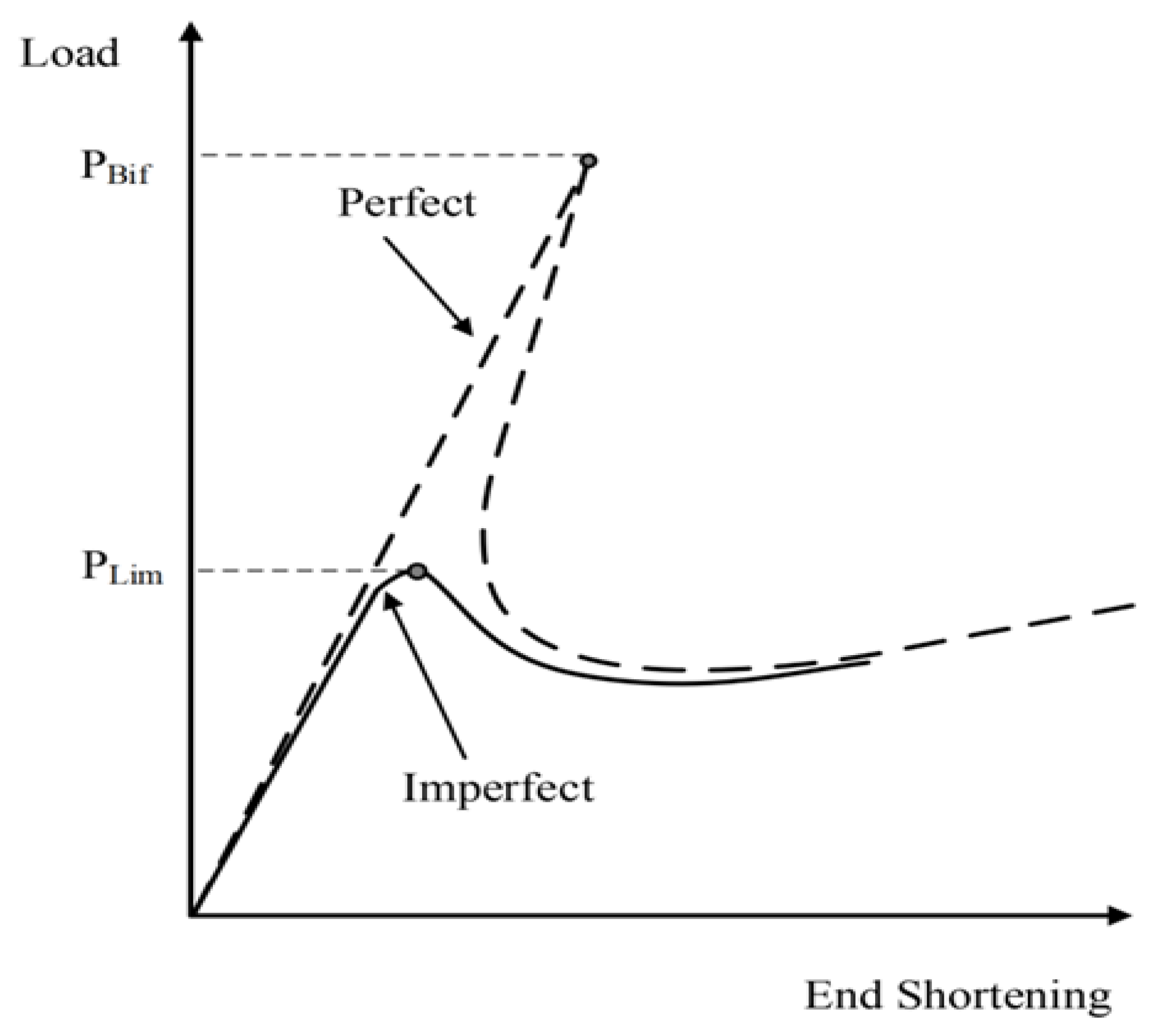

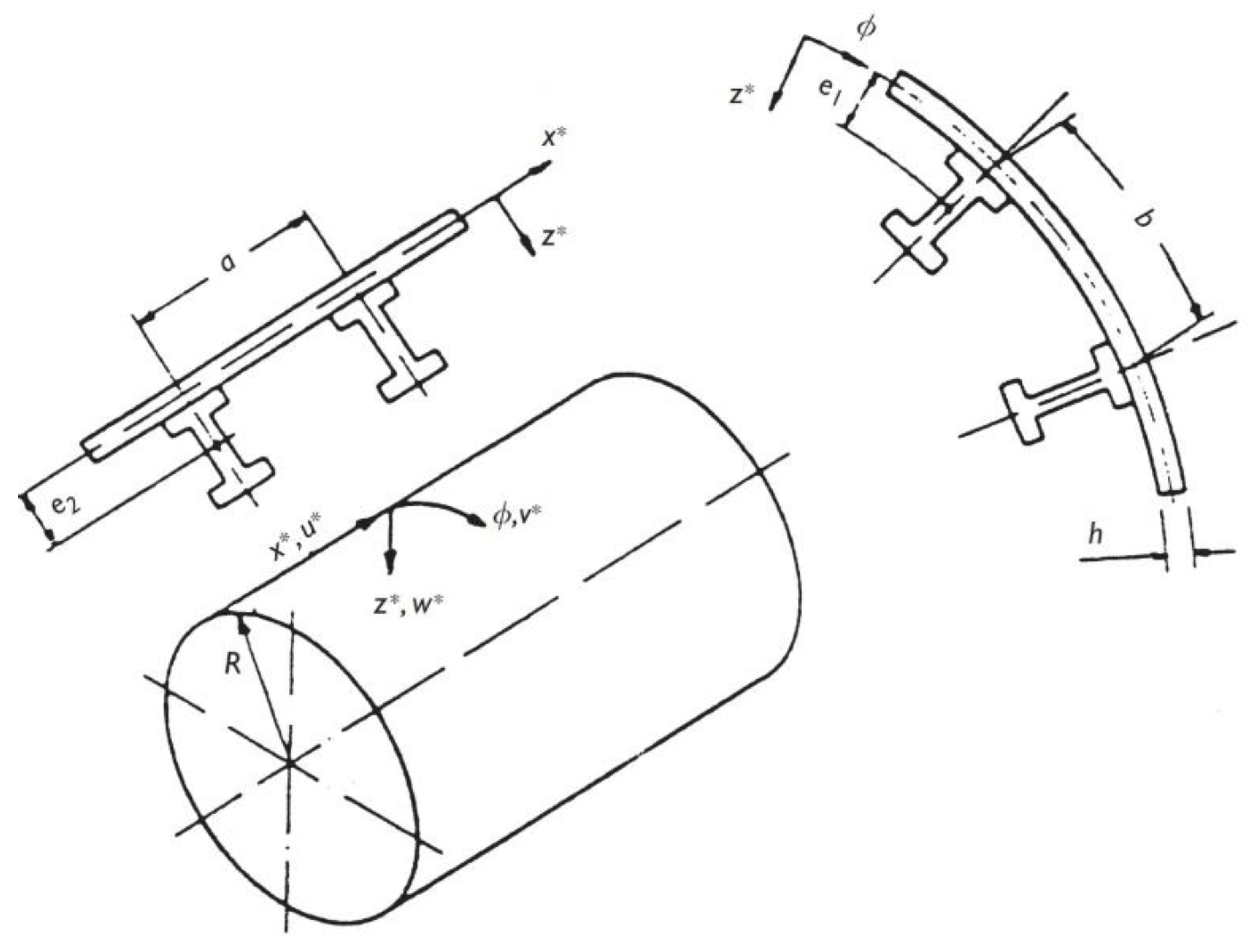
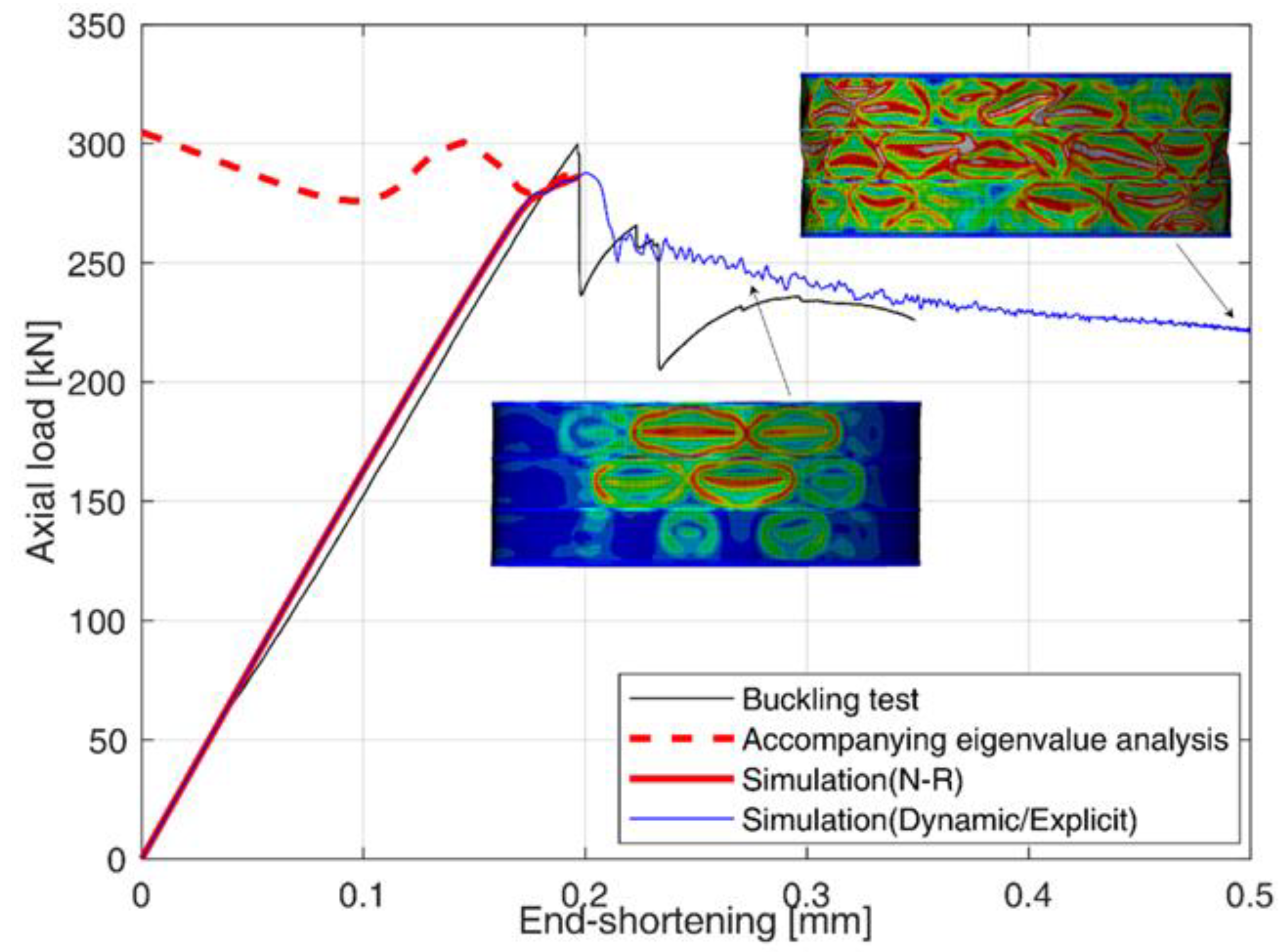
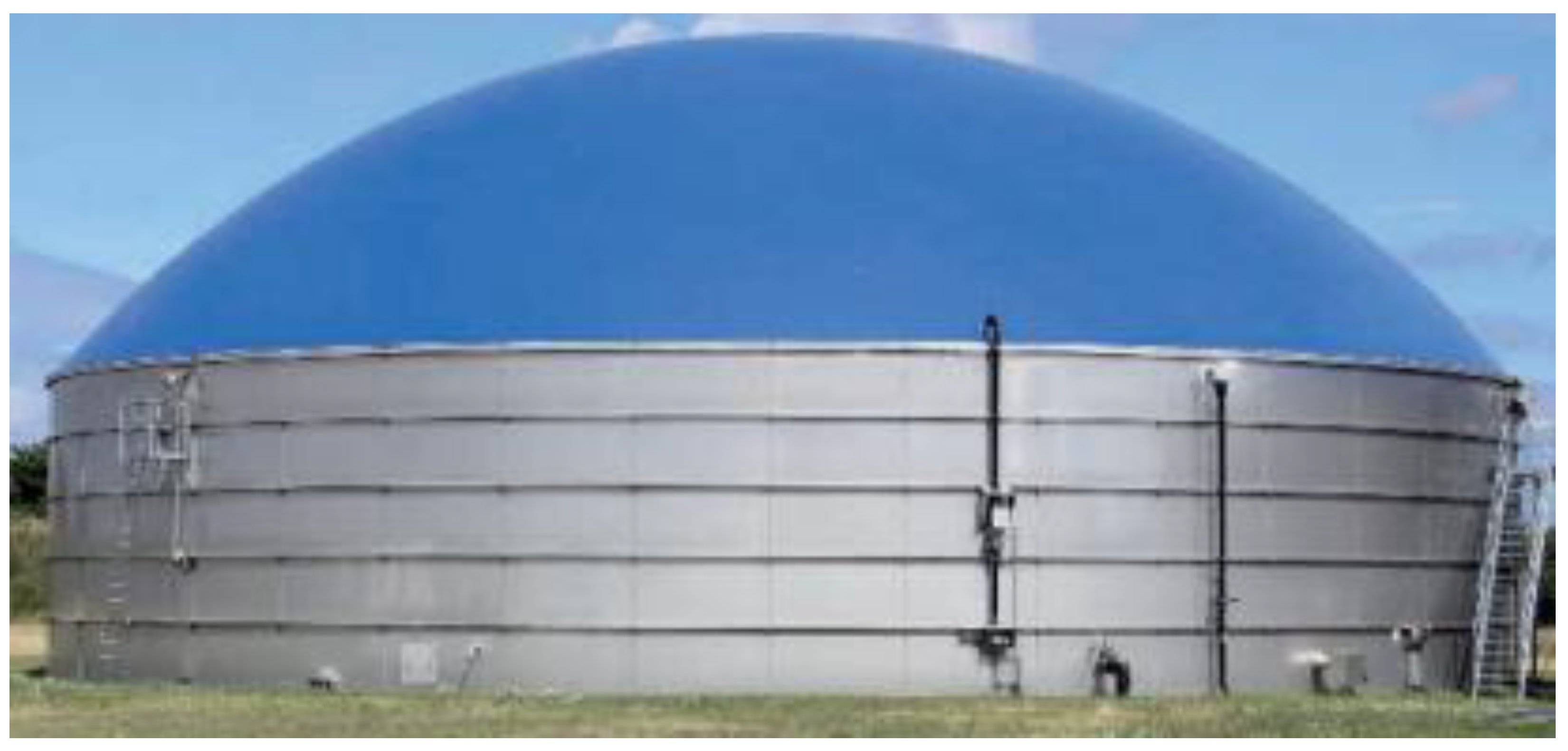
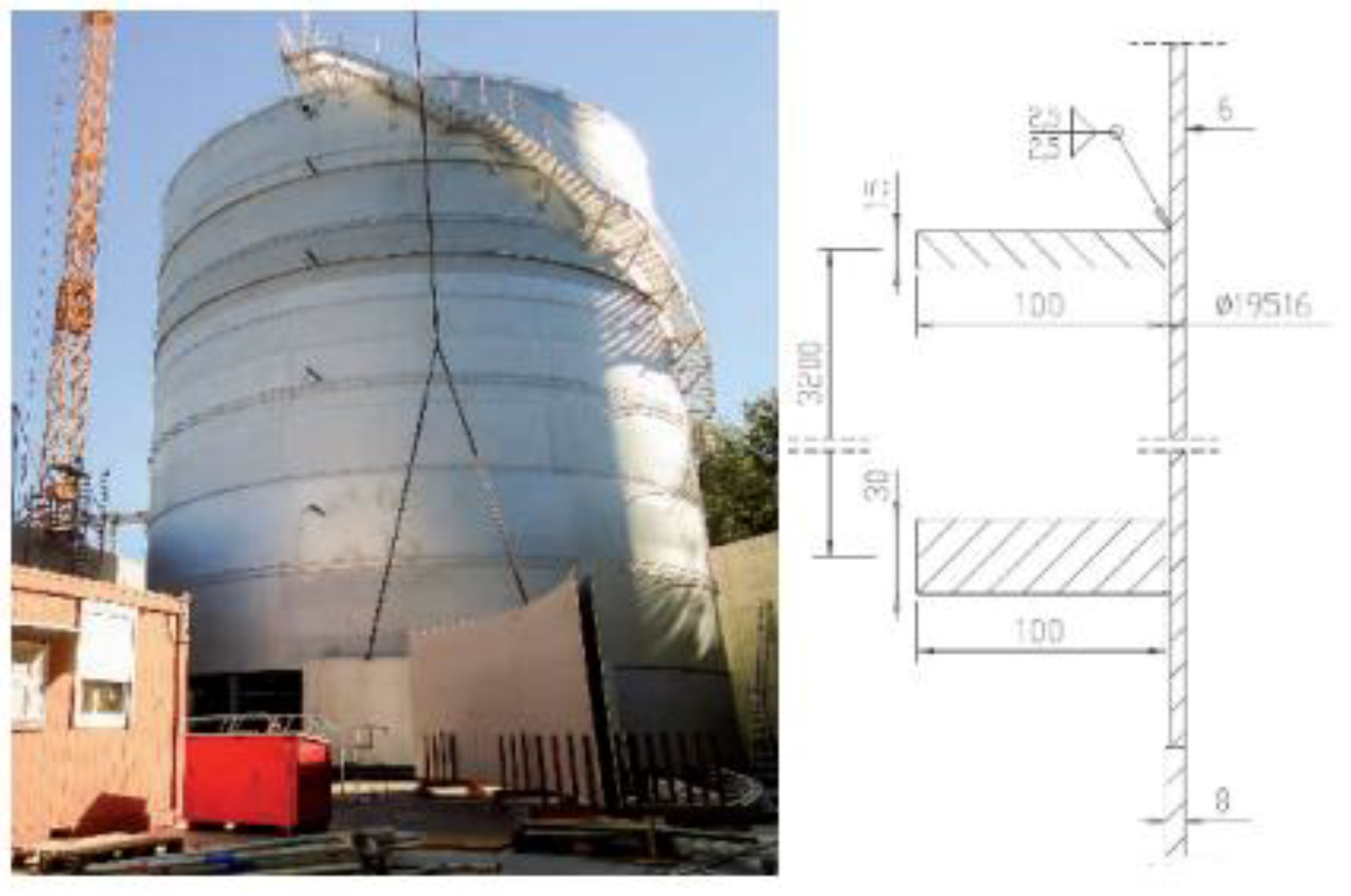

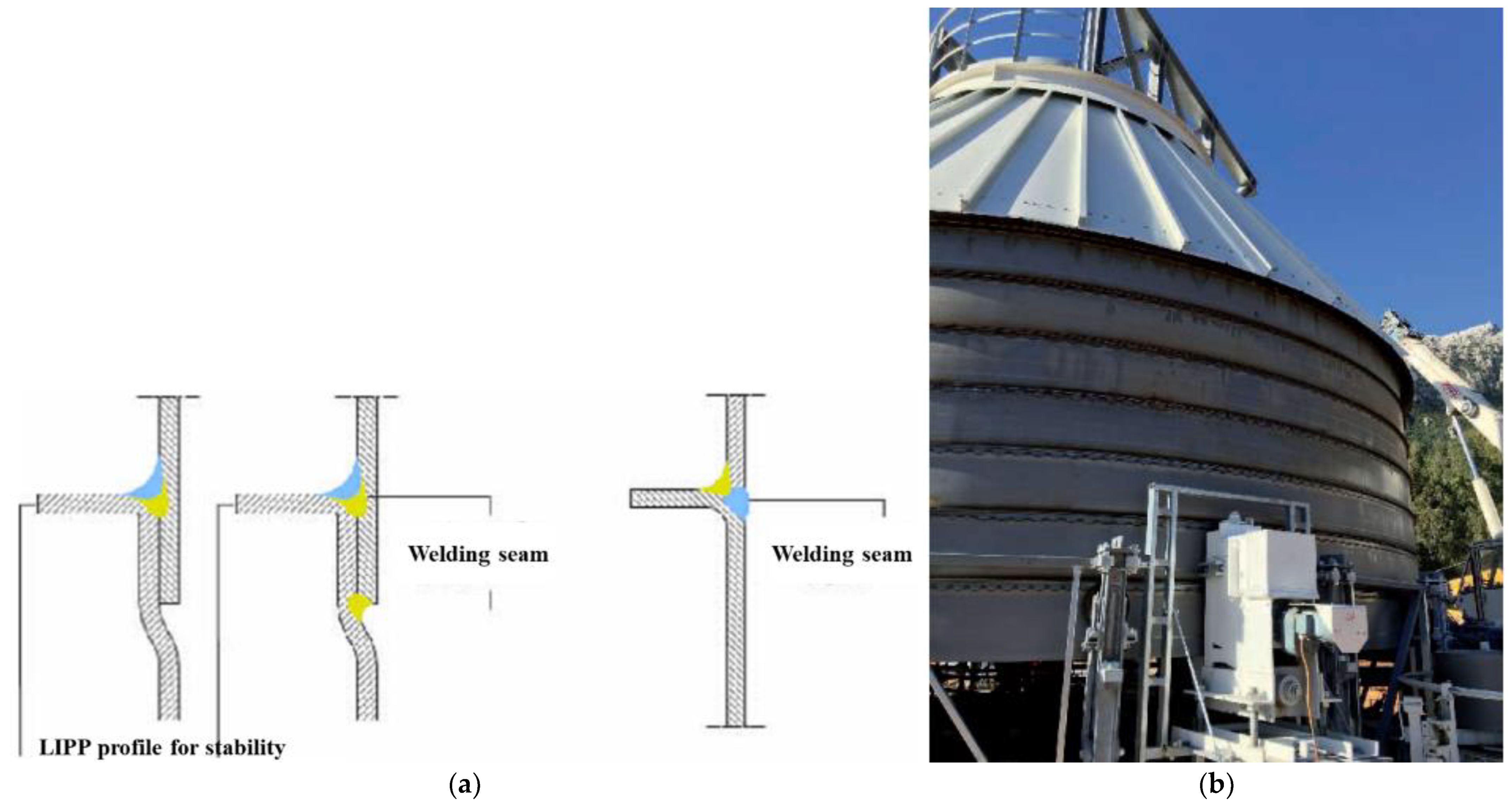

Publisher’s Note: MDPI stays neutral with regard to jurisdictional claims in published maps and institutional affiliations. |
© 2022 by the authors. Licensee MDPI, Basel, Switzerland. This article is an open access article distributed under the terms and conditions of the Creative Commons Attribution (CC BY) license (https://creativecommons.org/licenses/by/4.0/).
Share and Cite
Pasternak, H.; Li, Z.; Juozapaitis, A.; Daniūnas, A. Ring Stiffened Cylindrical Shell Structures: State-of-the-Art Review. Appl. Sci. 2022, 12, 11665. https://doi.org/10.3390/app122211665
Pasternak H, Li Z, Juozapaitis A, Daniūnas A. Ring Stiffened Cylindrical Shell Structures: State-of-the-Art Review. Applied Sciences. 2022; 12(22):11665. https://doi.org/10.3390/app122211665
Chicago/Turabian StylePasternak, Hartmut, Zheng Li, Algirdas Juozapaitis, and Alfonsas Daniūnas. 2022. "Ring Stiffened Cylindrical Shell Structures: State-of-the-Art Review" Applied Sciences 12, no. 22: 11665. https://doi.org/10.3390/app122211665
APA StylePasternak, H., Li, Z., Juozapaitis, A., & Daniūnas, A. (2022). Ring Stiffened Cylindrical Shell Structures: State-of-the-Art Review. Applied Sciences, 12(22), 11665. https://doi.org/10.3390/app122211665



